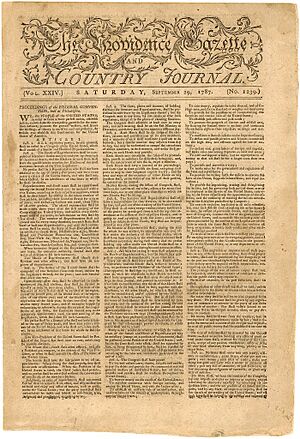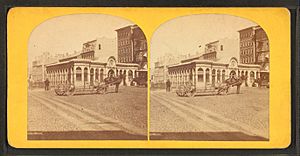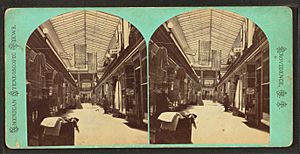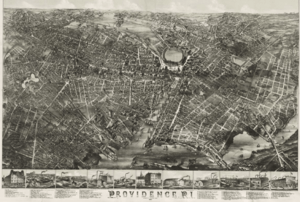Timeline of Providence, Rhode Island facts for kids
Providence, Rhode Island, is a city with a long and interesting past. It was founded by Roger Williams in 1636, making it one of the oldest cities in the United States. This timeline will take you through the most important moments in Providence's history, from its early days to the present. You'll learn about how the city grew, the challenges it faced, and the amazing things its people achieved.
Early Days: Before the 1800s
- 1636: Roger Williams, a religious reformer, founded Providence. He wanted a place where people could worship freely.
- 1638: The first Baptist group was formed in Providence.
- 1643-1644: Providence received a special paper, called a charter, from the government. This helped the town grow.
- 1675-1676: A big conflict, called King Philip's War, happened between the Narragansett people and the settlers. Many houses, including Roger Williams's, were burned.
- 1683: Roger Williams passed away.
- 1700: The North Burial Ground was created as a cemetery.
- 1753: The Providence Library Company was started, giving people a place to read and learn.
- 1762: The State House was built. Also, the Providence Gazette newspaper began publishing.
- 1764: College in the English Colony of Rhode Island and Providence Plantations was established in Warren, Rhode Island.
- 1770: The college moved to Providence. It later became known as Brown University.
- 1774: The Rhode Island Supreme Court was founded.
- 1775: The Market House and First Baptist Meetinghouse were built.
- 1776-1777: During the American Revolutionary War, soldiers used University Hall as a place to stay and a hospital.
- 1784: A big flood on the Moshassuck River caused a lot of damage.
- 1789: The Providence Society for Abolishing the Slave-Trade was created to fight against slavery.
- 1790: The city's population was 6,380 people.
- 1791: The Providence Bank was started. It was one of the first banks in the area.
- 1794: Serril Dodge opened his first jewelry store, starting Providence's famous jewelry industry.
The 1800s: Growth and Change
- 1800: The population grew to 7,614 people.
- 1801: A "Great Fire" destroyed 37 buildings, leaving many families without homes.
- 1805: Providence streets were given official names for the first time.
- 1810: The Cathedral of St. John was built. The population reached 10,071.
- 1815: The "Great Gale of 1815," a strong hurricane, caused a lot of damage and flooding.
- 1819: The Congdon Street Baptist Church was founded. It was the first independent Black church in Rhode Island.
- 1822: The Rhode Island Historical Society was founded to preserve the state's history.
- 1824: The first city directory was published. A race riot happened in Hard Scrabble.
- 1828: The Westminster Arcade was built. It was one of the first indoor shopping malls in the United States.
- 1829: The Providence Journal newspaper began publishing daily.
- 1830: Providence started to become a major textile manufacturing center.
- 1831: The Boston and Providence Railroad began operating. Another race riot occurred in Snow Town.
- 1832: Providence officially became a city. Samuel W. Bridgham was elected as the first mayor.
- 1833: David Brown opened a shop that later became Brown & Sharpe, a famous manufacturing company.
- 1836: The Providence Athenaeum was formed, a library and cultural center. The city hosted an Anti-Slavery convention.
- 1841-1842: The Dorr Rebellion took place, a fight for voting rights.
- 1843: Classical High School was established.
- 1844: Butler Hospital was founded to help people with mental health needs.
- 1846: Swan Point Cemetery was established. The John Carter Brown Library was also founded.
- 1847: The Providence and Worcester Railroad began operating. The Union Railroad Depot was built.
- 1854: A cholera outbreak swept through the city, especially affecting crowded areas.
- 1856: Thomas Howland became the first person of African heritage to hold office in Providence.
- 1860: The population reached 50,666.
- 1863: Rhode Island Hospital was founded.
- 1865: Rhode Island Locomotive Works produced many steam locomotives.
- 1871: Roger Williams Park was given to the people of Providence by Betsy Williams. City water service began, using water from the Pawtuxet River.
- 1872: Roger Williams Park Zoo was founded within the park.
- 1874: Construction began on the new City Hall.
- 1877: The Rhode Island School of Design and its museum were established.
- 1878: The Providence Grays baseball team was formed. The new Providence City Hall opened. The Providence Public Library opened its doors.
- 1884: The Providence Grays won the 1884 World Series championship in baseball.
- 1886: Thomas A. Doyle, Providence's longest-serving mayor, passed away.
- 1890: Providence's jewelry industry had over 200 companies and nearly 7,000 workers. The population was 132,146.
- 1892: The first electric streetcar began operating in the city.
- 1897: Emma Goldman, a famous speaker, was arrested for speaking in public at Market Square.
- 1900: Providence became the only capital city of Rhode Island. The population reached 175,597.
The 1900s: Modern Times Begin
- 1901: Providence's first sewage treatment plant began operating. The Rhode Island State House was built.
- 1905: The population was 198,635.
- 1908: The Federal Building was constructed.
- 1910: The population reached 224,326.
- 1913: The Turk's Head Building was constructed.
- 1914: The Macaroni Riots, a series of civil disturbances, occurred in Federal Hill. Johnson & Wales School of Business was formed.
- 1917: A Silent Parade was held by 1,800 African-Americans to protest racial violence.
- 1918: The Spanish flu epidemic hit Providence, causing many illnesses and deaths. Schools and public places were closed.
- 1925: The Cycledrome, a large bicycle track, opened.
- 1926: Miriam Hospital opened.
- 1928: Construction finished on the Industrial Trust Building (also known as the "Superman Building"). Providence author H. P. Lovecraft published his famous story The Call of Cthulhu. The Providence Steam Rollers won the NFL championship.
- 1938: A major hurricane struck the area.
- 1945: The Providence Journal newspaper won its first Pulitzer Prize.
- 1949: WJAR-TV began broadcasting television.
- 1950: Veterans Memorial Auditorium opened.
- 1954: Hurricane Carol caused significant damage to the area.
- 1956: The Providence Preservation Society was organized to protect historic buildings.
- 1958: Construction began on Interstate 95 and Interstate 195. These highways changed the city's layout.
- 1961: Construction started on the Fox Point Hurricane Barrier to protect the city from floods.
- 1964: Westminster Street was made into a pedestrian-only mall.
- 1966: The Fox Point Hurricane Barrier was completed.
- 1971: The Providence Public Schools began desegregation efforts.
- 1975: Buddy Cianci became mayor.
- 1978: The "Great Blizzard" brought nearly 28 inches of snow, paralyzing Providence. The city's jewelry industry reached its peak number of workers.
- 1980: The Crawford Street Bridge was named the "widest in the world" by the Guinness Book of World Records.
- 1984: Mayor Buddy Cianci resigned.
- 1986: Providence Station opened.
- 1989: The Westminster Mall was changed back to a street for cars.
- 1991: Buddy Cianci returned as mayor.
- 1994: Waterplace Park was constructed. WaterFire, a popular art installation, began.
- 1997: The Providence Children's Museum opened.
- 1999: Providence Place Mall opened.
The 2000s: Today's Providence
- 2001: Mayor Buddy Cianci faced federal charges.
- 2002: The Soviet submarine K-77 museum opened. Mayor Buddy Cianci was sentenced to prison.
- 2003: David Cicilline became mayor. He was the first openly gay mayor of a U.S. state capital.
- 2007: The Soviet submarine K-77 sank after a storm. Former mayor Cianci was released from prison.
- 2008: The historic Westminster Arcade closed for renovations.
- 2010: The population was 178,042. Severe rainstorms caused major flooding.
- 2011: Angel Taveras became mayor. Hurricane Irene caused many trees to fall and power outages.
- 2012: Hurricane Sandy hit Providence, but the Fox Point Hurricane Barrier protected the city from major damage.
- 2013: Winter Storm Nemo dropped 27 inches of snow. The historic Westminster Arcade reopened after its renovation. The landmark Industrial Trust Building, known as the "Superman Building," became empty.
- 2015: Jorge Elorza was sworn in as mayor. Kennedy Plaza reopened after major renovations.
- 2016: Former mayor Buddy Cianci passed away. His funeral procession marched through the city.
- 2018: Providence's first bicycle sharing program began.
- 2019: The Wexford Innovation Center opened. The Providence River Pedestrian and Bicycle Bridge opened.
- 2020: Due to the COVID-19 pandemic, many businesses and schools closed. Large Civil Rights protests took place in the city.
- 2021: A shooting in Washington Park wounded eight people, the largest number of victims in a single shooting in Providence's history.
- 2023: Brett Smiley was sworn in as the 39th mayor. A problem with the Washington Bridge caused major traffic issues.
- 2024: The Independent Man, a statue on top of the State House, was restored.
Images for kids

All content from Kiddle encyclopedia articles (including the article images and facts) can be freely used under Attribution-ShareAlike license, unless stated otherwise. Cite this article:
Timeline of Providence, Rhode Island Facts for Kids. Kiddle Encyclopedia.










